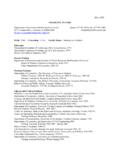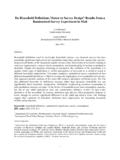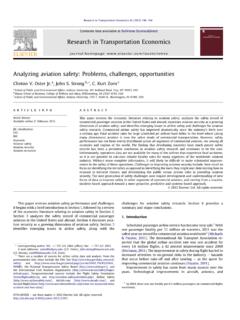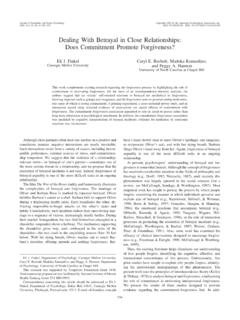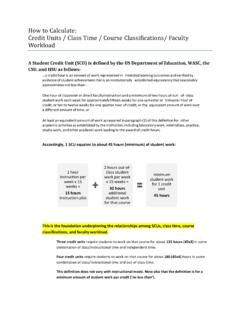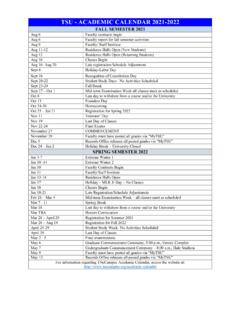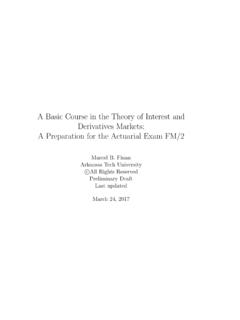Transcription of MACROECONOMICS - Northwestern University
1 MACROECONOMICS . 1880 1900 1920 1940 1960 1980 2000. Matthias Doepke University of Chicago Andreas Lehnert Board of Governors of the Federal Reserve System Andrew W. Sellgren George Mason University This book was typeset in Palatino and Computer Modern using LATEX. Draft of 1 September 1999. Chapters 5, 8, 9, and 11 Copyright c 1999, by Matthias Doepke. Chapters 10, 12, 13, 14, 17, 18, and 19 Copyright c 1999, by Andreas Lehnert. Chapters 1, 2, 3, 4, 6, and 15 Copyright c 1999, by Andrew W. Sellgren. All rights reserved. No part of this work may be reproduced in any form by any electronic or mechanical means (including, but not limited to, photocopying, recording, or informa- tion storage and retrieval) without permission in writing from the copyright owner.
2 The authors permit faculty, students, and staff of the University of Chicago to copy and distribute any part of this work for use in classes taught at the University of Chicago. Preface We have designed this book to be a supplement to Robert J. Barro's MACROECONOMICS , which is the textbook that is used in introductory MACROECONOMICS courses at the University of Chicago. In teaching these courses, we have found that Barro's treatment of the subject does not make use of the mathematical skills of our students. In particular, Barro relies almost exclusively on economic intuition and graphs to elucidate his subject. Since our students are familiar with calculus, we are able to work out formal models.
3 This almost always allows greater concreteness and concision. We have attempted to align our chapters with those in Barro's textbook. Sometimes our chapters present mathematical versions of the models that Barro introduces in his corre- sponding chapters (as in Chapters 2 and 19). Other times, our chapters contain material that extends his work (as in Chapters 5 and 17). Throughout, we have tried to add value to the treatment in Barro's book and to minimize redundancy. For example, we have nothing to add to Barro's Chapters 7, 16, and 20, so we have not covered those chapters. Three chapters deviate from this plan. Chapter 1 develops the mathematics of interest rates and growth rates; Barro does not cover these topics, but they are behind the scenes in his Chap- ter 1 and throughout his book.
4 Chapter 10, which covers unemployment, is completely unrelated to Barro's Chapter 10. It is intended as a companion to the book Job Creation and Destruction by Davis, Haltiwanger, and Schuh. Chapter 18 covers the relationship between the government budget constraint and in ation along the lines of the Unpleasant Mon- etarist Arithmetic of Sargent and Wallace. Although Barro has a sidebar on this topic in his Chapter 14, we feel that it is important enough to merit a chapter of its own. We chose Chapter 18 since it is a natural point between scal policy (Chapters 12, 13, and 14) and monetary policy (Chapter 19). Barro's Chapter 18 is a review of the empirical evidence on the effect of monetary shocks on the real economy, and is well worth covering.
5 There are exercises after each chapter, and we have provided complete solutions at the end of this book. We believe that exercises are essential for students to learn this material. They give students a sense of what they ought to know, since these exercises have been drawn from several years of exams. Also, we often use exercises to introduce extensions to the material in the text. We have attempted to estimate the dif culty of these exercises, labeling them as Easy, Moderate , or Hard . An exercise with a Hard rating may require a lot of algebra, or it may use unfamiliar concepts. Most other questions are rated iv Preface as Moderate , unless they have one-line solutions, in which case we usually rated them as Easy.
6 We teach this material in two ten-week courses. In the rst course we cover Chapters 1, 2, 3, 6, 4, 5, 7, 8, 9, and 11, in that order. This allows us to keep together all the material on monetary economics (Chapters 4, 5, 7, and 8). In the second course, we cover Chapter 10. (unemployment); Chapters 12, 13, and 14 ( scal policy); Chapters 15 and 16 (international macro); and Chapters 17, 18 and 19 (money and banking). Since this is quite a lot to cover in ten weeks, instructors of the second course have traditionally touched only brie y on unemployment and international macro and concentrated instead on monetary and scal policy.
7 The second course can bene t substantially from outside readings, such as: Rational Expectations and In ation by Thomas Sargent; A Monetary History of the United States by Mil- ton Friedman and Anna Schwartz; and Job Creation and Destruction by Davis, Haltiwanger, and Schuh. This book would not have been possible without the support of the Department of Eco- nomics at the University of Chicago and the encouragement of Grace Tsiang. We would also like to thank the many students and faculty who have helped us to develop this ma- terial. A number of exercises in the rst half of the book were based on questions written by Robert E.
8 Lucas, Jr. The material in the second half of this book has bene ted from sev- eral generations of instructors of Economics 203. In particular, Alexander Reyfman wrote a series of lectures which were the genesis of Chapters 12 through 19. Reyfman's teach- ing assistant Bill Dupor, and Lehnert's teaching assistants Jerry Cubbin and Tom Miles, all contributed valuable suggestions. During Cubbin's tenure as TA, he wrote most of the solutions to the problem sets, and several of these have found their way into this book. All students subjected to early drafts of this material contributed to the book's current form;. Shannon Thaden, Ben Ruff, and Calvin Chan deserve special mention.
9 In spite of all the comments and suggestions we have received, this book inevitably con- tains errors and omissions. We would be grateful if you would bring these to our attention. The authors can be reached by e-mail at: There is also a tear-out feedback form at the end of the book, along with a tear-out midterm- evaluation form for Economics 202 and 203. Finally, some of the material in this book involves policy prescriptions. At some level, policy is a matter of opinion. The opinions expressed herein are not necessarily those of the Board of Governors of the Federal Reserve System. Chicago, Illinois September 1999. Contents Preface iii 1 Preliminaries 1.
10 Compound Interest .. 1. Growth Rates .. 3. Exercises .. 5. 2 Work Effort, Production, and Consumption 9. Crusoe's Production Possibilities .. 9. Crusoe's Preferences .. 11. Crusoe's Choices .. 12. Income and Substitution Effects .. 17. Exercises .. 18. Appendix .. 19. 3 The Behavior of Households with Markets for Commodities and Credit 21. The General Setup .. 21. A Two-Period Model .. 23. An In nite-Period Model .. 28. vi Contents Exercises .. 30. 4 The Demand for Money 33. Exercises .. 36. 5 The Market-Clearing Model 39. A General Pure-Exchange Economy .. 39. Normalization of Prices .. 41. Walras' Law .. 42. The First Welfare Theorem.


